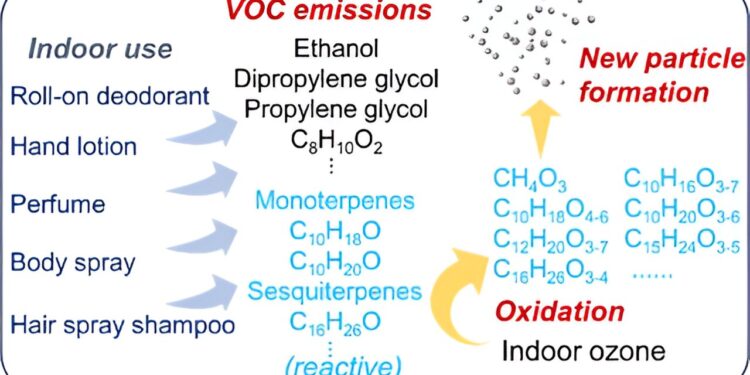Graphical summary. Credit: Letters on environmental science and technology (2024). DOI: 10.1021/acs.estlett.4c00353
The personal care products we use every day significantly affect indoor air quality, according to a new study led by an EPFL team. When used indoors, these products release a cocktail of more than 200 volatile organic compounds (VOCs) into the air, and when these VOCs come into contact with ozone, the ensuing chemical reactions can produce new compounds and particles that can penetrate deep into our environment. lungs. Scientists do not yet know to what extent daily inhalation of these particles affects our respiratory health.
The EPFL team’s conclusions were published in Letters on environmental science and technology.
It all started when Dusan Licina, tenure track assistant professor at EPFL, and his group compiled a seemingly mundane shopping list: roll-on deodorant, spray deodorant, hand lotion, perfume and dry shampoo, hairspray , all produced by major brands. and available in department stores in Europe and elsewhere.
Licina leads EPFL’s Human-Oriented Built Environment Lab (HOBEL) at the Smart Living Lab in Fribourg, which houses environmental chambers, unique experimental installations resembling real indoor spaces that enable precise quality control and monitoring indoor air.
The research project, led by former Licina postdoctoral fellow Tianren Wu, worked in association with German and Swedish researchers to mimic the use of these personal care products in an indoor environment. In a test, researchers applied the products under typical conditions, while air quality was carefully monitored. In another test, they did the same thing but also injected ozone, a reactive outdoor gas found in European latitudes during the summer months.
Ozone can enter homes through open windows, but can also come from indoors, for example when using laser printers and 3D printers. Around five sophisticated measuring instruments were deployed to quantify and identify gases and particles present in the chamber.
A cocktail of gases and particles
It took scientists two years to process all the data collected. In the first case, without ozone, more than 200 VOCs were emitted from personal care products, which gradually dissipated with ventilation. The most abundant molecules found were ethanol and monoterpenes, typically used in these products.
However, when ozone was introduced into the chamber, not only new VOCs but also new particles were generated, notably those from perfumes and sprays, exceeding the concentrations found in heavily polluted urban areas such as the central city of Zurich.
“Some molecules ‘nucleate,’ in other words, they form new particles that can coagulate into larger ultrafine particles that can effectively deposit in our lungs,” Licina explains. “In my opinion, we do not yet fully understand the health effects of these pollutants, but they may be more harmful than we think, especially because they are applied close to our breathing zone. This is a area in which further toxicological studies are necessary.
Preventive measures
To limit the effect of personal care products on indoor air quality, we could consider several alternatives in the way buildings are designed: introduce more ventilation, especially during product use, integrate ventilation devices air purification (e.g. activated carbon filters combined with multimedia filters) and limit indoor ozone concentration.
Another preventative measure is also recommended, according to Licina: “I know this is hard to hear, but we are going to have to reduce our dependence on these products, or if possible, replace them with more natural alternatives that contain scented compounds with low chemical reactivity. Another useful measure would be to raise awareness of these issues among health professionals and staff working with vulnerable groups, such as children and the elderly.
More information:
Tianren Wu et al, Indoor emissions, oxidation and new particle formation of volatile organic compounds related to personal care products, Letters on environmental science and technology (2024). DOI: 10.1021/acs.estlett.4c00353
Provided by the Ecole Polytechnique Fédérale de Lausanne
Quote: How Personal Care Products Affect Indoor Air Quality (October 10, 2024) retrieved October 10, 2024 from
This document is subject to copyright. Except for fair use for private study or research purposes, no part may be reproduced without written permission. The content is provided for informational purposes only.



